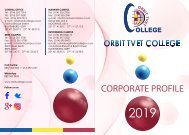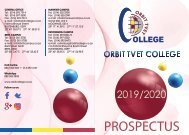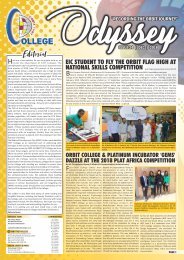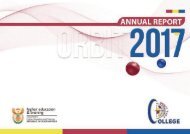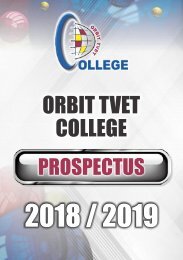Annual Report 2018 _Final
You also want an ePaper? Increase the reach of your titles
YUMPU automatically turns print PDFs into web optimized ePapers that Google loves.
<strong>2018</strong> <strong>Annual</strong> <strong>Report</strong> Page 149<br />
ORBIT TVET COLLEGE<br />
<strong>Annual</strong> Financial Statements for the year ended 31 December <strong>2018</strong><br />
Accounting Policies<br />
1.10 Impairment of non-cash-generating assets (continued)<br />
Value in use<br />
Value in use of non-cash-generating assets is the present value of the non-cash-generating assets remaining service<br />
potential.<br />
The present value of the remaining service potential of a non-cash-generating assets is determined using the following<br />
approach:<br />
Depreciated replacement cost approach<br />
The present value of the remaining service potential of a non-cash-generating asset is determined as the depreciated<br />
replacement cost of the asset. The replacement cost of an asset is the cost to replace the asset’s gross service potential.<br />
This cost is depreciated to reflect the asset in its used condition. An asset may be replaced either through reproduction<br />
(replication) of the existing asset or through replacement of its gross service potential. The depreciated replacement cost is<br />
measured as the current reproduction or replacement cost of the asset, whichever is lower, less accumulated depreciation<br />
calculated on the basis of such cost, to reflect the already consumed or expired service potential of the asset.<br />
The replacement cost and reproduction cost of an asset is determined on an “optimised” basis. The rationale is that the<br />
entity would not replace or reproduce the asset with a like asset if the asset to be replaced or reproduced is an<br />
overdesigned or overcapacity asset. Overdesigned assets contain features which are unnecessary for the goods or<br />
services the asset provides. Overcapacity assets are assets that have a greater capacity than is necessary to meet the<br />
demand for goods or services the asset provides. The determination of the replacement cost or reproduction cost of an<br />
asset on an optimised basis thus reflects the service potential required of the asset.<br />
Restoration cost approach<br />
Restoration cost is the cost of restoring the service potential of an asset to its pre-impaired level. The present value of the<br />
remaining service potential of the asset is determined by subtracting the estimated restoration cost of the asset from the<br />
current cost of replacing the remaining service potential of the asset before impairment. The latter cost is determined as the<br />
depreciated reproduction or replacement cost of the asset, whichever is lower.<br />
Service units approach<br />
The present value of the remaining service potential of the asset is determined by reducing the current cost of the<br />
remaining service potential of the asset before impairment, to conform to the reduced number of service units expected<br />
from the asset in its impaired state. The current cost of replacing the remaining service potential of the asset before<br />
impairment is determined as the depreciated reproduction or replacement cost of the asset before impairment, whichever is<br />
lower.<br />
Recognition and measurement<br />
If the recoverable service amount of a non-cash-generating asset is less than its carrying amount, the carrying amount of<br />
the asset is reduced to its recoverable service amount. This reduction is an impairment loss.<br />
An impairment loss is recognised immediately in surplus or deficit.<br />
Any impairment loss of a revalued non-cash-generating asset is treated as a revaluation decrease.<br />
When the amount estimated for an impairment loss is greater than the carrying amount of the non-cash-generating asset to<br />
which it relates, the entity recognises a liability only to the extent that is a requirement in the Standards of GRAP.<br />
After the recognition of an impairment loss, the depreciation (amortisation) charge for the non-cash-generating asset is<br />
adjusted in future periods to allocate the non-cash-generating asset’s revised carrying amount, less its residual value (if<br />
any), on a systematic basis over its remaining useful life.












